TOP PICKS
BUYING GUIDE
A chop saw, also known as a cut-off saw or abrasive saw, is a powerful tool designed for making straight, precise cuts in various materials, including metal, tile, and concrete. Primarily used in metalworking and construction, chop saws are favored for their speed and accuracy in cutting through hard materials. Whether you’re cutting steel pipes, rebar, or creating metal frames, choosing the right chop saw involves assessing its power, blade type, cutting capacity, and additional features that can enhance its functionality. This guide will help you navigate the key considerations when selecting the best chop saw for your projects.
Key Features to Consider
Power Source and Motor
- Corded vs. Cordless: Corded models offer continuous power for heavy-duty tasks, while cordless models provide portability and convenience but may have limited battery life.
- Motor Power: Measured in horsepower (HP) or amps, higher ratings indicate more powerful motors capable of cutting through tougher materials.
Blade Type and Size
- Abrasive vs. Carbide-Tipped Blades: Abrasive blades are common and cost-effective for metal cutting, while carbide-tipped blades are more durable and suitable for cutting denser materials.
- Blade Size: Determines the maximum cutting capacity. Common sizes range from 12 to 14 inches, with larger blades offering the ability to cut through thicker materials.
Cutting Capacity and Angles
- Maximum Cutting Depth: Important to consider based on the size of materials you frequently cut.
- Mitering Capability: Some chop saws offer the ability to make angled cuts, increasing their versatility.
Durability and Construction
- Build Quality: Durable construction, often featuring aluminum or steel, ensures the saw can withstand the rigors of heavy use.
- Base Stability: A solid base is crucial for accurate cuts. Look for models with a sturdy, wide base that minimizes vibration.
Safety Features
- Blade Guards: Protects the user from flying debris and accidental contact with the blade.
- Lock-Off Trigger: Prevents the saw from accidentally starting, enhancing safety during use.
Additional Features
- Quick-Release Vise: Allows for fast and secure clamping of materials.
- Spindle Lock: Simplifies the process of changing blades.
- Dust Collection System: Helps manage dust and debris, particularly important when cutting materials like concrete or tile.
Pros and Cons
| Pros of Chop Saws | Cons of Chop Saws |
|---|---|
| ⚡ Efficient and precise cuts in hard materials | 💸 Higher-end models can be expensive |
| 🛠️ Suitable for a wide range of materials | 🔄 Generally limited to straight cuts |
| 🎨 Some models offer mitering capabilities for angled cuts | 🔊 Can be loud and produce significant dust and debris |
| 🏗️ Durable construction designed for heavy use | 🏋️♂️ Heavy and less portable, especially larger models |
Quick Tips
1️⃣ Assess Your Material Needs: Determine the types of materials you’ll be cutting most often to choose the appropriate blade and power level.
2️⃣ Consider Portability: If you need to move the chop saw between sites, consider the weight and whether a cordless model fits your needs.
3️⃣ Invest in Safety Equipment: Due to the nature of chop saws, investing in protective gear like goggles, gloves, and dust masks is crucial.
Selecting the best chop saw for your needs involves balancing power, blade type, cutting capacity, and safety features. A well-chosen chop saw can be a game-changer for construction and metalworking projects, offering the ability to make quick, accurate cuts through tough materials. Consider the specific requirements of your projects, including the materials you’ll be cutting and the frequency of use, to ensure you invest in a chop saw that meets your needs. Remember, the longevity and performance of your chop saw also depend on proper maintenance and the use of high-quality blades suited to your cutting tasks.








